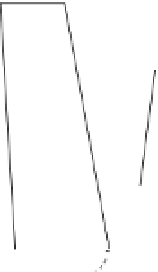Biomedical Engineering Reference
In-Depth Information
SARCOMERE
SARCOMERE
MYOSIN
A BAND
H ZONE
Z LINE
I BAND
ACTIN
FIGURE 3.38
The sarcomere is the basic functional unit of skeletal muscles and extends from one Z line to the
next. Actin filaments are attached to the Z lines and extend into the A band, where they overlap with the thicker
myosin filaments. The H zone is the portion of the A band that contains no overlapping actin filaments. When
the muscle changes from its extended, relaxed position (left panel) to its contracted state (right panel), the myosin
filaments use cross-bridges to slide past the actin filaments and bring the Z lines closer together. This results in
shorter sarcomeres and a contracted muscle.
the sarcomere. The cross-bridges are then released and reformed at a different active site
further along the thin filament. This results in a motion that is similar to the hand-over-
hand motion that is used to pull in a rope. This action, the sliding filament mechanism, is
driven by ATP energy and results in shortening of the muscle. Shortening of the muscle
components (contraction) results in bringing the muscle's attachments (e.g., bones) closer
together (Figure 3.38).
Muscle fibers have connections with nerves. Sensory nerve endings are sensitive to
length, tension, and pain in the muscle and send impulses to the brain via the spinal cord,
whereas motor nerve endings receive impulses from the brain and spinal cord that lead to
excitation and contraction of the muscle. Each motor axon branches and supplies several
muscle fibers. Each of these axon branches loses its myelin sheath and splits up into a
number of terminals that make contact with the surface of the muscle. When the nerve is
stimulated, vesicles in the axon terminals release a neurotransmitter, acetylcholine, into
the synapse between the neuron and the muscle. Acetylcholine diffuses across the synapse
and binds to receptors in a special area, the motor end plate, of the sarcolemma. This causes
the sodium channels in the sarcolemma to open up, and an action potential is produced in
the muscle fiber. The resulting action potential spreads over the entire sarcolemmal surface
and travels down all of the T tubules, where it triggers a sudden massive release of calcium
by the cisternae. Calcium triggers the production of active sites on the thin filaments so
cross-bridges with myosin can form and contraction occurs. Acetylcholinesterase breaks
down the acetylcholine while the contraction process is under way so the original relatively
low permeability of the sarcolemma to sodium is restored.










































































































































































































































